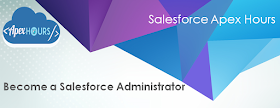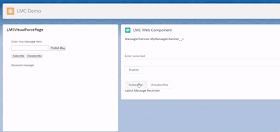We are glad that we did Free Salesforce Admin Training in 2019 at ApexHours. Good news is that we recorded all sessions and uploaded all Salesforce training videos on our YouTube Channel. We created this Training program for a Student and new System admin to becoming a Salesforce Administrator.
This Salesforce Administrator Training for Beginners covered the all below topics:-
In this episode we learned about what is Cloud computing and Introduction to Salesforce. In Episode 1, we covered the following topics :-
In this episode we covered data model in Salesforce, Difference between Master-detail and Lookup fields. We also talk about depended picklist and schema builder. Here is agenda of session Episode 2.
Here is recording of "Customize Salesforce User Interface" episode recording.
In episode 5 we talks about the declarative tools available on Salesforce to automate business processes using workflow and process builder. In this episode we talk about what is the difference between Workflow and Process Builder. And when we should use Process Builder over the workflow. In Episode 5, we will cover the following topics :-
Here is recording of "Workflow, Email Template and Process Builder" episode recording.
In this episode we talk about how to automate your business process with flow, Difference between Workflow Vs Process Builder Vs Lightning Flow, Know the Nomenclature between Lightning flow Vs Flow Builder Vs Flow Interview. In Episode 6, we will cover the following topics :-
In this episode we talk about how to setup the Approval process in Salesforce and what is delegated Approver in Salesforce. In Episode 7, we coverd the following topics :-
Here is recording of "Setup Approval process in Salesforce" episode recording.
In this episode we talk about what is the difference between Profiles and role and Permission Sets. How to enforce field level security and User Management. In Episode 8, we covered the following topics :-
In this session we talk about Organization Wide Defaults(OWD) in salesforce and Sharing Setting. Difference between Record Ownership and Record Sharing and Profile Vs Roles. In Episode 9, we will cover the following topics :-
In this session we talk about audit logs and field history Tracking include debug logs. In Episode 10, we will cover the following topics
In Episode 11, we will cover the following topics :-
Here is recording of "Data Loader & Import Wizard" episode recording.
This episode talks about the tools available to effectively report on the data within Salesforce to measure performance in Key Business Areas. In Episode 12, we will cover the following topics :-
All the best for your Salesforce certifications.
We did 12+ sessions with our 5 speakers ( Jigar Shah, Amit Singh, Atul Rajguru and Purushottam Bhaigade , Jayesh) and we got 1300+ registration.
Thank you so much for all our Apex Hours Speaker to help all Student.
Here is some more useful playlist for New Salesforce Developer or Admin.
1) Setup Salesforce Community
2) Basic of Java Script.
3) Marketing Cloud.
Thanks,
Amit Chaudhary
This Salesforce Administrator Training for Beginners covered the all below topics:-
- Introduction to Cloud Computing and Salesforce
- Modelling Data in Salesforce
- Customizing the User Interface
- Aggregating & Validating Salesforce Data
- Automating Business Processes - Part 1(Process Builder and Workflow)
- Automating Business Processes - Part 2 (Flow)
- Automating Business Processes - Part 3 (Approval process)
- Managing Data Access
- Who Sees What in Salesforce?
- Auditing & Troubleshooting Errors
- Data Management with Salesforce
- Making Sense of your Salesforce Data
Episode 1 – Introduction to Salesforce
In this episode we learned about what is Cloud computing and Introduction to Salesforce. In Episode 1, we covered the following topics :-
- Fundamentals of Cloud Computing
- Customer Relationship Management Basics
- Creating your first Salesforce org
- Salesforce Classic Vs Lightning Experience
- Q & A
Episode 2 – Model your Salesforce Data
In this episode we covered data model in Salesforce, Difference between Master-detail and Lookup fields. We also talk about depended picklist and schema builder. Here is agenda of session Episode 2.
- Conventional Database Tables Vs Objects
- Standard and Custom Objects
- Datatypes
- Relational Data Modelling
- Schema Builder
- Q & A
Episode 3 – Customize the Salesforce User Interface
In this episode we talk about customizing Salesforce user interface to improve user experience. After checking this recording you will learn how to create Application & Tab in Salesforce, What is record Types and App Builder. In Episode 3, we covered the following topics :-
- App Manager & Tabs
- Customizing Page Layouts using Record Types
- List Views & Related Lists
- Mini & Compact Page Layouts
- App Builder
- Q & A
Episode 4 – Aggregating & Validating Data
Aggregating and validating data is fundamental for all Salesforce application. This episode talks about putting validations, Duplicate Rules within Salesforce to enforce data integrity and aggregating relational records. In Episode 4, We will cover the following topics :-
- Formula field
- Data Aggregation using Roll-up Summaries
- Validation Rules
- Duplicate Rules
- Q & A
Here is recording of "Aggregating & Validating Data" episode recording.
Episode 5 – Automating Business Process with Workflow, Email Template and Process Builder.
In episode 5 we talks about the declarative tools available on Salesforce to automate business processes using workflow and process builder. In this episode we talk about what is the difference between Workflow and Process Builder. And when we should use Process Builder over the workflow. In Episode 5, we will cover the following topics :-
- What is a Business Process?
- Automating Processes using
- Workflow Rule
- Process Builder
- Email Templates
- Q & A
Here is recording of "Workflow, Email Template and Process Builder" episode recording.
Episode 6 – Automating Business Processes with Flow.
In this episode we talk about how to automate your business process with flow, Difference between Workflow Vs Process Builder Vs Lightning Flow, Know the Nomenclature between Lightning flow Vs Flow Builder Vs Flow Interview. In Episode 6, we will cover the following topics :-
- Declarative Tools for Business Process Automation
- Assignment Rules
- Flow Builder
- Q & A
Episode 7 – Automating Business Processes with Approval Process.
In this episode we talk about how to setup the Approval process in Salesforce and what is delegated Approver in Salesforce. In Episode 7, we coverd the following topics :-
- Declarative Tools for Business Process Automation
- Approval Process
- Q & A
Episode 8 – Managing Data Access in Salesforce
In this episode we talk about what is the difference between Profiles and role and Permission Sets. How to enforce field level security and User Management. In Episode 8, we covered the following topics :-
- Profiles & Permission Sets
- Enforcing Field Level Security
- User Management
- Q & A
Episode 9 – Who Sees What in Salesforce
In this session we talk about Organization Wide Defaults(OWD) in salesforce and Sharing Setting. Difference between Record Ownership and Record Sharing and Profile Vs Roles. In Episode 9, we will cover the following topics :-
- OWD & Sharing Settings
- Record Ownership
- Record Sharing
- Profiles Vs Roles
- Q & A
Episode 10 – Audit & Troubleshoot Salesforce Data
In this session we talk about audit logs and field history Tracking include debug logs. In Episode 10, we will cover the following topics
- Audit Logs & Field History Tracking
- Debug Logs
- Email Logs
- Login History & IP Whitelisting
- Q & A
Here is recording of "Audit & Troubleshooting of Salesforce Data" episode recording.
Episode 11 – Data Management in Salesforce
In Episode 11, we will cover the following topics :-
- Data Loader
- Uploading Relational Data in Salesforce
- Best Practices for Data Management
- Q & A
Here is recording of "Data Loader & Import Wizard" episode recording.
Episode 12 – Reports & Dashboards.
This episode talks about the tools available to effectively report on the data within Salesforce to measure performance in Key Business Areas. In Episode 12, we will cover the following topics :-
- Report Types
- Standard & Custom Report Types
- Dashboards
- Share and Schedule Report/Dashboard
- Q & A
All the best for your Salesforce certifications.
We did 12+ sessions with our 5 speakers ( Jigar Shah, Amit Singh, Atul Rajguru and Purushottam Bhaigade , Jayesh) and we got 1300+ registration.
Thank you so much for all our Apex Hours Speaker to help all Student.
Here is some more useful playlist for New Salesforce Developer or Admin.
1) Setup Salesforce Community
2) Basic of Java Script.
3) Marketing Cloud.
Thanks,
Amit Chaudhary








